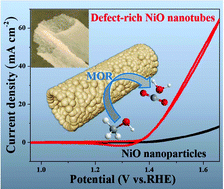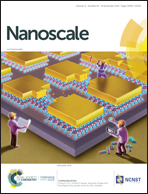Self-template synthesis of defect-rich NiO nanotubes as efficient electrocatalysts for methanol oxidation reaction†
Abstract
Developing robust and inexpensive non-noble metal based anode electrocatalysts is highly desirable for alkaline direct methanol fuel cells (ADMFCs). Herein, we successfully develop a facile self-template synthetic strategy for gram-grade porous NiO nanotubes (NTs) by pyrolyzing a nanorod-like Ni-dimethylglyoxime complex. The pyrolysis temperature highly correlates with the morphology and crystallinity of NiO NTs. The optimal NiO NTs exhibit a large electrochemically active surface area, a fast catalytic kinetics, and a small charge transfer resistance, which induce an outstanding electrocatalytic activity for the methanol oxidation reaction (MOR). Compared with conventional NiO nanoparticles, NiO NTs achieve a 11.5-fold increase in mass activity at 1.5 V for the MOR due to nanotubal morphology and abundant non-vacancy defects on the NiO NT surface. Moreover, NiO NTs have a higher electrocatalytic activity for the intermediates of the MOR (such as formaldehyde and formate) than conventional NiO nanoparticles, which also contribute to MOR activity enhancement. Given the facile synthesis and enhanced electrocatalytic performance, NiO NTs may be promising anode electrocatalysts for ADMFCs.

- This article is part of the themed collection: 2019 Nanoscale HOT Article Collection


 Please wait while we load your content...
Please wait while we load your content...